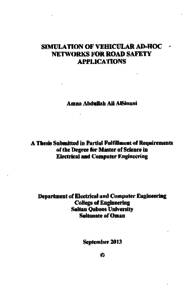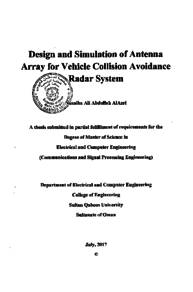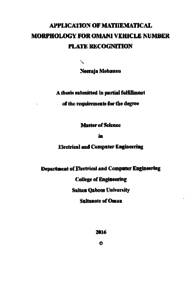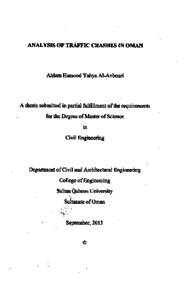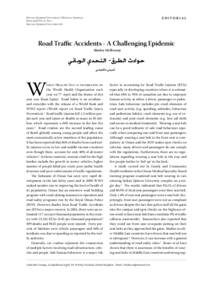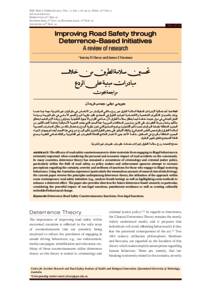وثيقة
Simulation of vehicular AD-HOC networks for road safety applications
الناشر
Sultan Qaboos University
ميلادي
2013
اللغة
الأنجليزية
الملخص الإنجليزي
ABSTRACT
Vehicular Ad-Hoc Network (VANET) is a technology that uses moving cars as nodes in a wireless mobile network. VANET turns every participating car into a wireless router or an end node, allowing cars approximately 100 to 300 meters away from each other to connect and, in turn, create a network with a wide range. As cars fall out of the signal range and drop out of the network, other cars can join in, connecting vehicles to one another such that a mobile network is created. There are different classes of VANET applications with different Quality-of-Service (QoS) requirements. Safety applications received most attention since they can significantly decrease the number of road accidents and seem quite promising at reducing the number of fatal roadway accidents by providing early warnings. In this thesis, three VANET simulation tools are reviewed. These simulation tools are NCTUns, GrooveNet and NS2. There is a large number of simulators used to study the behavior of VANETS, the selection of these tools was made based on a study recommendation for NCTUns and GrooveNet as the most suitable tools to simulate VANETs safety applications from the simulation requirements point of view. In terms of popularity, NS2 remains the most popular simulator used by VANET researchers world-wide. Hence it was selected for theoretical review. In this hnical comparison was made between these simulators after a thorough review. Also, limitation in simulating multi-channel operations was highlighted in NS2 simulator and a patch was used to overcome this limitation. Vehicular Ad-hoc Networks implement a wireless technology called Dedicated Short Range Communications (DSRC) at spectrum of 5.9 GHz, as allocated by the Federal Communications Commission (FCC). The IEEE 1609.4 Standard for Wireless Access in Vehicular Environments (WAVE) has been proposed to enhance the performance of vehicular networks by dividing this allocated spectrum into 6 Service CHannels (SCH) and 1 Control CHannel (CCH) of 10 MHz each. An overview of this protocol is presented. Exchange of vehicle movement information is essential for large class of safety applications. This information is included in periodic broadcast (HELLO) messages transmitted during Control Channel intervals. However, the protocol tight channel synchronization produces issues that have a dramatic impact on the performance of safety-related applications with strict delivery ratio and delay requirements.
A study was performed in [2] to investigate the impact of IEEE 1609.4 channel switching and strict synchronization on the performance of safety applications in VANET. In this thesis, a highway VANET scenario is simulated to further investigate the impact of the IEEE 1609.4 channel scheduler on the performance of delay constrained vehicular applications. Simulation results are analyzed and compared with the aforementioned study. In addition, more scenarios are simulated and studied in order to find out the effect of topographical changes on these applications performance. Also, the impact of the multi-channel operations protocol on the performance of safety applications were highlighted in these set of simulations,
المجموعة
URL المصدر
الملخص العربي
ملخص المشروع الشبكات الارتجالية للمركبات، أو VANET هي تقنية تستخدم المركبات المتحركة كنقاط في شبكة لاسلكية الإنشاء شبكة متحركة. شبكة VANET تحول كل مركبة فيها إلى جهاز موجه لاسلكي أو نقطة طرفية، مما يسمح للمركبات التي تبعد ۱۰۰ إلى ۳۰۰ متر من بعضها البعض بالتواصل، ومن ثم، إنشاء شبكة ذات نطاق واسع. حينما تخرج المركبات من نطاق الإشارة اللاسلكية وتفقد الاتصال مع الشبكة اللاسلكية، يمكن لمركبات أخرى الانضمام لهذه الشبكة ويتم ربط المركبات مع بعضها البعض بحيث يتم إنشاء شبكة متحركة أوسع. هناك فنات مختلفة من التطبيقات الخاصة بشبكة VANET مع اختلاف متطلبات جودة الخدمة. ولقد تلقت تطبيقات السلامة قدر كبير من الاهتمام لأنها يمكن أن تقلل من عدد حوادث الطرق بشكل كبير وتبدو واعدة جدا في الحد من عدد الحوادث المميتة في الطرقات من خلال توفير الإنذارات المبكرة لقائدي المركبات المختلفة في هذا البحث، تتم مراجعة ثلاثة من أدوات المحاكاة عبر الحاسب الآلي لشبكة إلى VANET. هذه الأدوات هي GrooveNet ، NCTUns و NS2. في الواقع هناك عدد كبير من برامج المحاكاة المستخدمة لدراسة سلوك شبكات الVANET، إن اختيار هذه البرامج جاء بناء على توصية من عدد من الدراسات والبحوث لبرنامجی NCTUns و GrooveNet لكونهما البرنامجان الأكثر مناسبة لمحاكاة تطبيقات السلامة في VANET. أما من حيث الشعبية، فإن NS2 لا يزال برنامج المحاكاة الأكثر استعمالا من قبل الباحثين في جميع أنحاء العالم الشبكات VANET. ومن ثم تم اختياره للمراجعة النظرية في هذا البحث، تم إجراء مقارنة تقنية بين أدوات المحاكاة بعد مراجعتهم مراجعة مستفيضة. أيضا، تمت الإشارة إلى قصور في أداء محاكاة NS2 في الجانب المتعلق بمحاكاة القنوات اللاسلكية المتعددة، وتم أيضا استخدام أداة patch لتخطي هذا القصور. إن الشبكات الارتجالية للمركبات تعمل على تقنية لاسلكية عرف ب الاتصالات المخصصة قصيرة المدى (DSRC) في الطيف الترددي 5, ۹ غيغاهرتز، كما تم تخصيصه من قبل لجنة الاتصالات الاتحادية (FCC). وقد اقترح بروتوكول 1609. 4 IEEE لتنظيم الوصول اللاسلكي في بيئة المركبات (WAVE) لتعزيز أداء الشبكات من خلال تقسيم الطيف المخصص إلى 6 قنوات خاصة بالخدمات (SCH) وقناة واحدة خاصة بالتحكم (CCH) لكل منها طیف ۱۰ ميغاهرتز. لذلك فإن تبادل المعلومات الخاصة بحركة المركبات أمر ضروري لفئة كبيرة من تطبيقات السلامة، يتم تضمين هذه المعلومات في رسائل (HELLO) يتم بثها بصفة دورية خلال فترات CCH. ومع ذلك، فإن التزامن الصارم للقنوات الضيقة كما هو الحال في هذا البروتوكول. ينتج بعض المشاكل التي يكون لها تأثير سلبي على أداء التطبيقات المتعلقة بالسلامة التي تتطلب معدة عالية من نسبة تسليم الرسائل ومتطلبات صارمة بخصوص تأخير التسليم في هذا البحث، تتم محاكاة شبكة VANET في الطريق السريع بغرض دراسة تأثير جدولة القنوات اللاسلكية في بروتوكول 1609. 4 IEEE على أداء تطبيقات السلامة ذات الطبيعة الصارمة في التأخير، وكذلك يتم تحليل نتائج المحاكاة في عدد من السيناريوهات بهدف التعرف على تأثير تغيرات البيئة الطوبوغرافية على أداء هذه التطبيقات. أيضا تمت الإشارة إلى تأثير بروتوكول القنوات اللاسلكية المتعددة على أداء تطبيقات السلامة في عدد من تجارب المحاكاة.
قالب العنصر
الرسائل والأطروحات الجامعية

